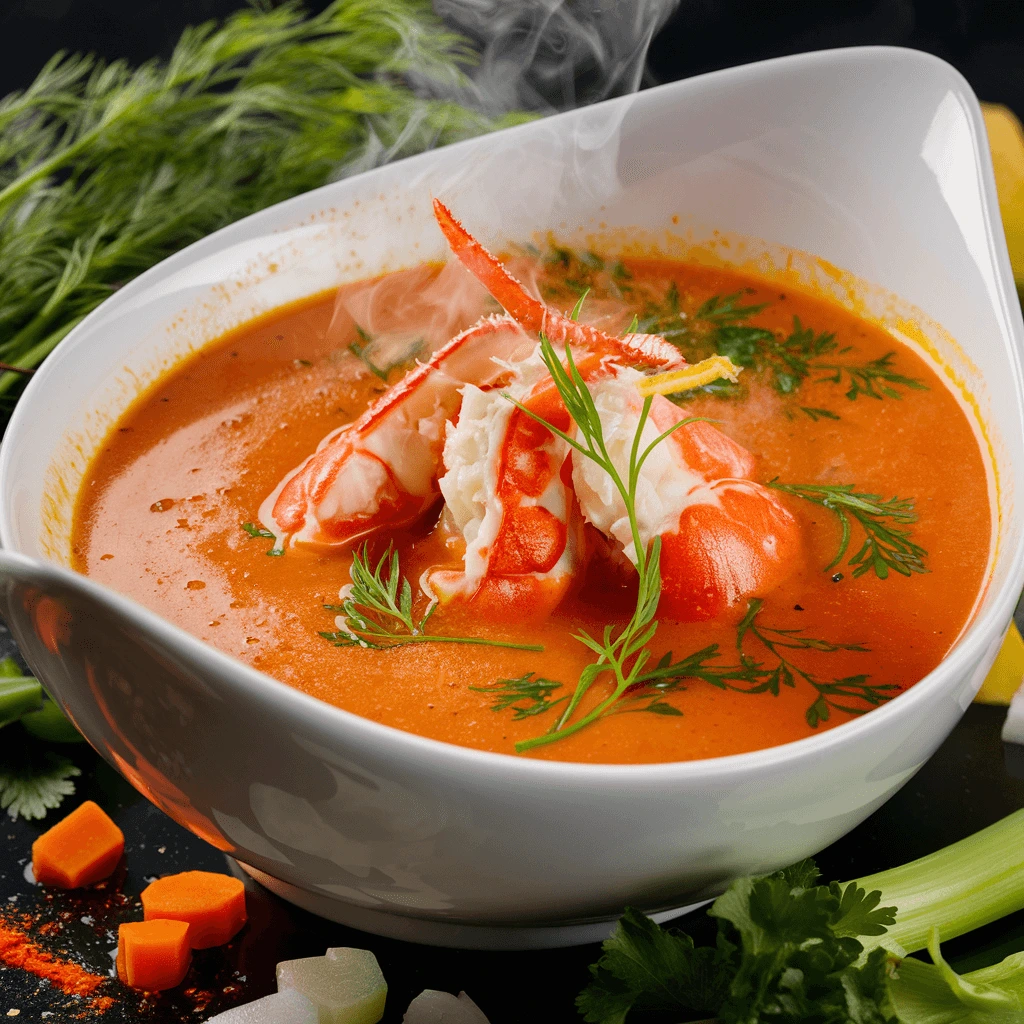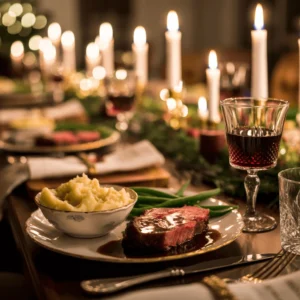Lobster bisque is tasty and is a standout in dinner recipes — rich, creamy, and full of deep seafood flavor, it’s the perfect way to add a touch of luxury to your meal.
Introduction
Lobster bisque stands as a true jewel of classic French cuisine—a dish that embodies elegance, sophistication, and centuries of culinary tradition. The origins of bisque can be traced back to the 17th century, with the earliest recorded use of the term appearing in François Pierre de La Varenne’s influential cookbook, Le Cuisinier François, published in 1651. At that time, “bisque” referred to a double-cooked soup, often made with game birds that were first sautéed and then simmered in a rich broth thickened with bread. It wasn’t until the 19th century that the dish evolved into the creamy, shellfish-based soup we know today, with lobster, crayfish, or crab simmered with aromatic vegetables, flambéed with cognac, and puréed to achieve its signature velvety texture and deep, concentrated flavor.
Although lobster was once considered a humble ingredient—so plentiful in North America that it was fed to prisoners and servants—over time, it gained prestige as a symbol of luxury and celebration. In France, lobster bisque became a staple of festive banquets and fine dining, prized for its delicate balance of richness and subtlety. The labor-intensive preparation, which involves extracting every ounce of flavor from the shells and carefully blending the broth with cream and brandy, elevates the bisque to a dish worthy of special occasions.
Today, lobster bisque is a highlight of holiday feasts and elegant dinner parties, especially around Christmas and New Year’s. Its creamy consistency, complex layers of flavor, and striking presentation make it a showstopper on any menu—a dish that transforms an ordinary meal into a memorable culinary experience. Whether served as a starter at a grand celebration or as the centerpiece of a cozy family gathering, lobster bisque never fails to impress and delight.
Ingredients of Lobster Bisque recipe
2 whole lobsters (about 1.5 lbs each)
2 tablespoons olive oil
1/4 tasse de cognac
1/2 cup sweet white wine
1 small leek, finely chopped
1 zucchini, diced
2 celery stalks, diced
1 fennel stalk, diced
1 tablespoon tomato paste
3 garlic cloves, minced
1 tablespoon mild curry paste
4 cups homemade fish or seafood stock
Salt and white pepper to taste, 1 teaspoon turmeric
Fresh chives and coriander for garnish
How to Choose a Good Lobster (Fresh, Live, Quality Criteria):
For the best bisque, always opt for a live, cold-water lobster—these are known for their sweet, firm meat and superior flavor. Look for lobsters that are lively and active, with their tails curled tightly under their bodies and claws that move or resist when touched. The shell should be hard and intact, indicating a high meat yield and freshness. Avoid sluggish lobsters or those with cloudy eyes, as these are signs of poor quality or age. If buying pre-cooked lobster or just the tails, the meat should be opaque white, firm to the touch, and have a fresh ocean scent—never gray or with an ammonia odor. For the best texture and flavor, select lobsters weighing between 1 and 2 pounds.
Execution
Prepare the lobsters : Boil salted water, cook lobsters for 8–10 minutes until red. Remove meat, reserve shells, and cut meat into bite-sized pieces.
Infuse the Turmeric: In a small bowl, combine the turmeric with a tablespoon of warm water to allow the flavors to infuse. Set aside…
Make the Seafood Stock: In a large pot, heat the olive oil over medium heat. Add the lobster shells, leek, zucchini, fennel, and garlic. Sauté until the vegetables are softened and the lobster shells begin to break apart.
Deglaze with Cognac and Wine: Pour in the cognac and allow it to flame (if you’re using gas) to burn off the alcohol. Then, add the sweet white wine and simmer for 5 to 7 minutes until the liquid reduces by half.
Add Curry Paste and Stock: Stir in the curry paste, mixing well to coat all the ingredients. Add the seafood stock and bring it to a boil. Reduce the heat and let it simmer for 40 to 50 minutes to concentrate the flavors.
Strain the Broth: Strain the broth through a fine mesh sieve, pressing lightly on the solids to extract as much liquid as possible. Discard the shells and vegetables.
Finish the Bisque: Return the strained broth to the pot. Add the turmeric infusion and lobster meat. Pour in the coconut milk and let the bisque simmer for another 10 to 15 minutes. Season with salt and pepper to taste.
Serve: Ladle the bisque into bowls, garnish with fresh chives and a few coriander leaves for a fresh touch. You can also add a little lime zest for extra brightness.
Additional tips for Lobster Bisque recipe
- Balance the richness with a squeeze of fresh lemon or lime juice just before serving.
- Add a splash of sherry or Pernod at the end to elevate the bisque with a subtle herbal note.
- Roast the lobster shells before making the stock for a deeper, richer flavor.
If you liked this recipe, you can find another tasty lobster bisque version on this site: Perfect Lobster Bisque.
Recipe Variations
Quick Weeknight Version:
For busy evenings, use pre-cooked lobster meat or high-quality shrimp, and a good store-bought seafood stock to cut down on prep time. Skip the step of making stock from shells—simply sauté aromatics, add seafood, broth, and cream, and blend for a fast, flavorful bisque ready in under 30 minutes.
Vegetarian Bisque Ideas:
Create a vegetarian “bisque” by replacing lobster with a medley of sea-flavored vegetables such as roasted fennel, leeks, celery, and seaweed. For added richness and protein, smoked tofu or marinated mushrooms can mimic the texture of shellfish. Use vegetable stock enhanced with a splash of soy sauce or miso for depth.
Ways to Spice It Up or Lighten the Bisque:
- For a spicy kick, add a pinch of cayenne pepper, a dash of hot sauce, or a spoonful of curry paste during cooking.
- To lighten the bisque, substitute heavy cream with coconut milk or half-and-half, and use extra vegetables for body instead of flour or roux.
- Add fresh herbs like tarragon, dill, or chives before serving for a burst of freshness.
These tips and variations will help you adapt your lobster bisque recipe for any occasion, budget, or dietary preference—all while maximizing flavor and enjoyment!
FAQs – Tasty Lobster Bisque (Dinner Recipe)
1. Can I use frozen lobster?
Yes, thaw it completely before cooking. Fresh is best, but frozen works well too.
2. What part of the lobster do I use?
Mainly the tail meat for tenderness and flavor. You can also use shells to make a richer broth.
3. Can I substitute the cream?
Yes, use half-and-half, coconut milk (for a twist), or a light cream if you prefer a lighter version.
4. Is lobster bisque good for meal prep?
Yes. Store in the fridge up to 3 days or freeze for up to 1 month. Reheat gently on the stove.
5. Can I make it ahead of time?
Definitely. It often tastes even better the next day as the flavors develop.
6. What can I serve with lobster bisque?
Crusty bread, a light salad, or garlic croutons make great sides.
7. Is this recipe gluten-free?
Not by default. If using flour to thicken, replace with cornstarch or a gluten-free flour blend.
8. How do I thicken my bisque?
Simmer longer or add a small slurry of cornstarch and water for extra thickness.
9.Budget-Friendly Alternatives:
If lobster is out of budget or unavailable, you can easily substitute with langoustines, large shrimp, or even crayfish. These shellfish still provide a rich, briny flavor and work well in bisque. For an even more affordable option, use a mix of shrimp and white fish, or rely on high-quality seafood stock as a base. While the taste will differ, these alternatives allow you to enjoy a luxurious soup without the premium price tag
10.Wine Suggestions for Cooking and Pairing:
A splash of dry white wine such as Sauvignon Blanc, unoaked Chardonnay, or Muscadet is perfect for deglazing the pan and infusing the bisque with subtle acidity and fruitiness7. When serving, pair your lobster bisque with a crisp white wine—Sancerre, Chablis, or Riesling are excellent choices. For a richer bisque or if serving with creamy accompaniments, a mellow white Burgundy or a fruity rosé also works beautifully. If you prefer red, choose a light, low-tannin wine like Pinot Noir.




Comments are closed.